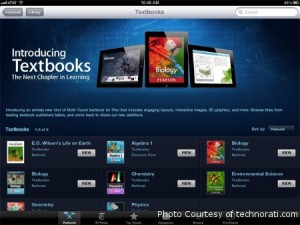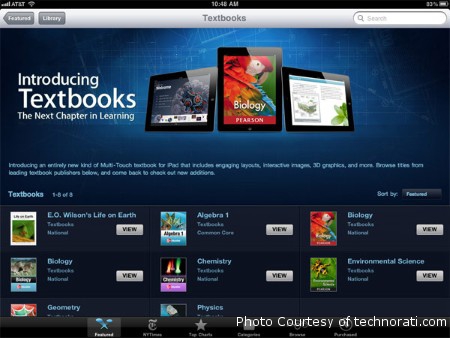
Recently, Apple updated their application iBooks to include textbooks and announced a new application called iBooks Author, allowing students and teachers alike to build their own books. This new app, iBooks 2, includes many features not present in older versions of the application. iBooks is available on the iTouch, iPhone, and iPad.
However, all of these devices are very expensive. The average student at Leesville High School takes 4 classes per semester, and for the sake of simplicity, we will assume that the student will use 6 textbooks per year. With iPads costing around $500 and 6 iBooks clocking in at 15 dollars a piece, the school would have to pay roughly $1,260,000 the first year, and around $189,000 per year after. Although this is quite expensive, the pros of these iBooks far exceed the cons.
One of the cons of paper textbooks is that for years students have had to carry around large and heavy textbooks for all of their classes. These books are sometimes older and are physically falling apart, but schools have to reuse them in order to make ends meet. The books still work, and students can still learn from them, but they might be outdated. Saving money by reusing books is a pro, but having to use books that might be old and beaten up is a con.
This is where the new iBooks come in. These days kids grow up surrounded by technology, so the textbooks that students learn from should be electronic as well. A child will also most likely learn better from a textbook that shares similar characteristics with video games and other leisure-time activities.
Some of the features included in the new iBooks app are interactive videos, pictures, and text, 3D images, the ability to highlight text with the swipe of a finger, note taking on the page, and study cards. Videos can be embedded in the pages of the book to allow students to see them with the touch of a finger. The pictures are high quality and sometimes 3D, and the student can zoom in to see the smallest details by touching the screen. Another feature is the ability to link to certain parts of text using study cards and notes, which are further explained below.
What really separates the iBook from its paper counterpart are the note taking and study abilities. Students can highlight with the swipe of a finger, touch text and type to take notes, and their highlights and vocab are automatically made into study cards. With studying so convenient, students will most likely do better on assignments, and tasks that normally take a lot of time, such as making flashcards and taking notes, will be done more often now that they are much easier and less time-consuming. Highlighting will also help children learn because they will be able to tell at a glance what is the most important part to study, and will be able to study that more effectively, further helping them on tests and other assignments.
Paper textbooks used today in high school cost around 60-80 dollars and are used for multiple years to help cut down on costs. However, these books’ costs are further lowered when they are used by multiple students per year, sometimes cutting the costs to as low as $2-5 dollars per year, per student user. These iBooks cost 15 dollars or less per year; however, schools would be required to repurchase the software every year. iPads are very expensive, but 1.5 million iPads are already used in education and there are also around 20,000 educational apps in the app store, which far outweighs the costs.
For teachers and students who want to make their own textbooks, the app iBooks Author is completely free, allowing books to be made and published instead of bought, cutting down on costs.
All in all, iBooks are a revolutionary new way to read and study in schools, and hopefully will cut down on paper textbook use. One day, iBooks might be as common as paper textbooks are today, as they are both convenient and useful.

Leave a Reply